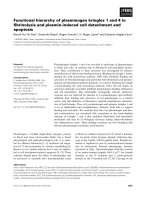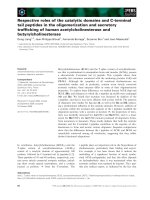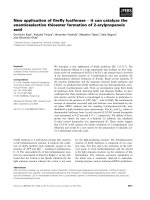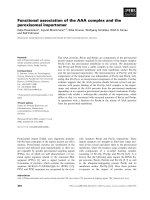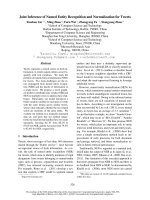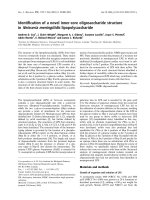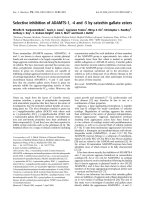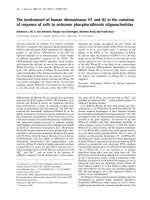báo cáo khoa học: " New sources of soybean seed meal and oil composition traits identified through TILLING" docx
Bạn đang xem bản rút gọn của tài liệu. Xem và tải ngay bản đầy đủ của tài liệu tại đây (320.94 KB, 11 trang )
BioMed Central
Page 1 of 11
(page number not for citation purposes)
BMC Plant Biology
Open Access
Research article
New sources of soybean seed meal and oil composition traits
identified through TILLING
Emily C Dierking
1
and Kristin D Bilyeu*
1,2
Address:
1
University of Missouri-Columbia, Division of Plant Sciences, 110 Waters Hall, Columbia, MO 65211, USA and
2
USDA-ARS, Plant
Genetics Research Unit, 110 Waters Hall, Columbia, MO 65211, USA
Email: Emily C Dierking - ; Kristin D Bilyeu* -
* Corresponding author
Abstract
Background: Several techniques are available to study gene function, but many are less than ideal
for soybean. Reverse genetics, a relatively new approach, can be utilized to identify novel mutations
in candidate genes; this technique has not produced an allelic variant with a confirmed phenotype
in soybean. Soybean raffinose synthase genes and microsomal omega-6 fatty acid desaturase genes
were screened for novel alleles in mutagenized soybean populations.
Results: Four mutations in independent lines were identified in the raffinose synthase gene RS2;
two mutations resulted in amino acid mutations and one resulted in an altered seed oligosaccharide
phenotype. The resulting phenotype was an increase in seed sucrose levels as well as a decrease in
both raffinose and stachyose seed oligosaccharide levels. Three mutations in independent lines
were identified in the omega-6 fatty acid desaturase gene FAD2-1A; all three mutations resulted in
missense amino acid mutations and one resulted in an altered seed fatty acid profile that led to an
increase in oleic acid and a decrease in linoleic acid in the seed oil.
Conclusion: The oligosaccharide phenotype controlled by the novel RS2 allele is similar to
previously observed seed oligosaccharide phenotypes in RS2 mutant (PI 200508) allele-containing
lines. Due to the anti-nutritional characteristics of raffinose and stachyose, this represents a
positive change in seed composition. The fatty acid phenotype controlled by the novel FAD2-1A
allele controls an increase in oleic acid in the seed oil, a phenotype also observed in a line previously
characterized to have a null allele of the FAD2-1A gene. Molecular marker assays were developed
to reliably detect the inheritance of the mutant alleles and can be used in efficient breeding for these
desired seed phenotypes. Our results serve as the first demonstration of the identification of
soybean mutants controlling seed phenotypes discovered through the reverse genetics technique
TILLING.
Background
Reverse genetics is potentially a powerful strategy used to
identify novel, induced mutations in candidate genes. Uti-
lizing reverse genetics allows us to take advantage of genes
characterized in other plant genomes and use this knowl-
edge to create a pool of candidate genes in soybean which
can then be screened for genotypic variants. The function
of the gene is further characterized by identifying pre-
dicted mutant phenotypes. Alternatively this technique
can be applied to genes with known function to create an
Published: 14 July 2009
BMC Plant Biology 2009, 9:89 doi:10.1186/1471-2229-9-89
Received: 24 April 2009
Accepted: 14 July 2009
This article is available from: />© 2009 Dierking and Bilyeu; licensee BioMed Central Ltd.
This is an Open Access article distributed under the terms of the Creative Commons Attribution License ( />),
which permits unrestricted use, distribution, and reproduction in any medium, provided the original work is properly cited.
BMC Plant Biology 2009, 9:89 />Page 2 of 11
(page number not for citation purposes)
allelic series to avoid possible lethality issues in genes
essential for plant growth or development. The recent
release of the soybean genome sequence is an especially
valuable asset for soybean reverse genetics.
Targeting Induced Local Lesions IN Genomes (TILLING)
is a reverse genetics technique that serves as a high
throughput method to identify unique, chemically
induced mutations within target genes which have poten-
tial to change gene expression and/or function [1-3]. We
developed two soybean TILLING populations utilizing
the chemical mutagen ethyl-methanesulfonate (EMS) as
part of an effort to provide a resource to identify novel
alleles of genes with a role in soybean seed composition
traits [4]. Chemical mutagenesis, either EMS or NMU (N-
nitroso-N-methylurea) typically induces single nucleotide
polymorphisms; these point mutations are extremely use-
ful both for studying gene function as well as for their
potential use in crop improvement [4]. The mutants are
generally characterized by knocked-down or altered gene
function rather than a knock-out; for the populations
used in this study, the previously characterized mutation
distributions were 45 or 33% missense, 51 or 58% silent,
and 4 or 8% truncation [4].
Previously, a number of techniques which were first
proven in other crops have been applied to soybean func-
tional genomics studies, but each strategy has obstacles in
terms of efficiency, directness, timing, and regulatory
issues. Transformation of soybean with either Agrobacte-
rium tumefaciens or A. rhizogenes has been effective in stud-
ying gene function, although it is not very efficient [5] and
can be limited by genotype specificity [6]. Directed co-
suppression, overexpression of genes, and RNAi have all
been utilized to gain insights into gene function and pro-
duce desired phenotypes in transgenic soybeans [7-10].
While the use of transgenic technology is suitable for traits
that can be utilized broadly for commodity soybeans, the
current regulatory environment is prohibitive to extensive
use of transgenic technology for many individual soybean
traits.
The more traditional forward genetics approach relies on
the identification of a mutant phenotype followed by the
investigation of the causative gene. Forward genetics
screening has historically been a very valuable strategy to
identify different sources of soybean traits. However,
screening divergent germplasm or induced mutant popu-
lations may fail to deliver the desired phenotype when
multiple genes are involved. In soybean, the genome
functions as diploid, but it has undergone rounds of
genome duplication that often results in functional
genetic redundancy [11-15].
The objective of this work was to take advantage of the
availability of soybean candidate genes that were known
to control seed composition traits as targets for the TILL-
ING reverse genetics strategy; the goal was to identify
novel mutant alleles that could be characterized for desir-
able seed phenotypes. Our targets were a raffinose syn-
thase (EC 2.4.1.82) and an omega-6 fatty acid desaturase
(EC 1.3.1.35) controlling seed oligosaccharide levels and
oleic acid levels in the seed oil, respectively.
Raffinose synthase catalyzes the biochemical reaction to
produce raffinose from sucrose and galactinol. Stachyose
is formed in a stepwise reaction utilizing raffinose and
galactinol as substrates. Both raffinose and stachyose are
indigestible by monogastric animals and are therefore
considered anti-nutritional components of soybean meal.
Previously, the PI 200508 allele of RS2 was associated
with the increased sucrose and low raffinose and stachy-
ose seed phenotype [16].
In addition to the targeted raffinose synthase candidate
gene, we screened for novel mutant alleles of the soybean
seed-expressed omega-6 fatty acid desaturase gene FAD2-
1A. This fatty acid desaturase catalyzes the conversion of
oleic acid precursors into linoleic acid precursors that
accumulate in the seed oil [17,18]. Mutations in FAD2-1A
have been recovered previously using a forward genetics
strategy, and result in an increase in oleic acid levels and a
decrease in linoleic acid levels, a phenotype desirable for
cooking and industrial oils. The elevated oleic acid soy-
bean line M23 was induced by X-ray mutagenesis and has
been shown to have a genomic deletion that includes the
FAD2-1A gene; a second elevated oleic acid soybean line
contained a single base deletion in the FAD2-1A gene
[18,19]. Cooking oil is in demand that contains elevated
oleic acid and decreased linolenic acid. Although the
genetic combining ability for mutant alleles of the FAD2-
1A gene and microsomal omega-3 fatty acid desaturase
(FAD3) genes has been reported, the exact relationship
between increased oleic acid levels and decreased lino-
lenic acid levels has not been clearly defined [[20,21] K.
Bilyeu, unpublished]. The oleic acid level in soybean seed
oil has been demonstrated to be very sensitive to the envi-
ronment [22], which has complicated the identification
and analysis of elevated oleic acid soybean lines.
Results
Identification of soybean raffinose synthase (RS2) mutant
alleles
Previously, mutations in the soybean raffinose synthase
gene, RS2, have been shown to result in an increase in
seed sucrose and a decrease in raffinose and stachyose
[16]. Reverse genetics screening of the EMS mutagenized
populations created the potential to find additional muta-
tions in RS2 and confirm the contribution of this gene to
the seed oligosaccharide phenotype in soybean. A portion
of the RS2 gene [GenBank: EU651888
] was screened for
mutations utilizing the TILLING strategy [4]; four lines
BMC Plant Biology 2009, 9:89 />Page 3 of 11
(page number not for citation purposes)
were identified which contained single nucleotide poly-
morphisms (SNPs). These lines were subsequently con-
firmed by sequence analysis to contain independent RS2
mutations. The four identified lines all contained a SNP
typical of EMS mutagenesis, G/C to A/T transitions. Two
of the mutations did not result in amino acid changes and
therefore were not considered candidates for phenotypic
characterization. The other two lines, designated 165 and
397, contained mutations which resulted in missense
amino acid changes (Figure 1)[23].
DNA from M
2
tissue of line 165 contained a homozygous
SNP (c448t in the coding sequence) resulting in S150F
amino acid change. DNA from M
2
tissue of line 397 con-
tained a heterozygous SNP (c319t in the coding sequence)
resulting in a T107I amino acid change. The induced
mutations in both line 165 and 397 lie in semi-conserved
regions of plant raffinose synthase gene sequences (Figure
1). M
3
seedlings from lines 165 and 397 were character-
ized for the RS2 alleles, and the homozygous and segre-
Raffinose synthase amino acid sequence alignments in the regions surrounding the induced mutations in the RS2 geneFigure 1
Raffinose synthase amino acid sequence alignments in the regions surrounding the induced mutations in the
RS2 gene. Amino acid positions are indicated at the beginning of each alignment. The position of the polymorphic amino acid
is indicated by an asterisk. Identical amino acid residues are highlighted in black while similar amino acid residues are highlighted
in gray. A. The exon one region containing the induced mutation in line 165 which resulted in S150F. B. The exon one region
containing the induced mutation in line 397 which resulted in T107I. C. Weblogo output of the amino acid conservation of
raffinose synthase enzymes aligned as part of the BLINK feature at NCBI />BLINK_tut2.html using GI number 187610414. Amino acid positions within the protein are listed on the X axis. The overall
height for each amino acid column stack indicates the sequence conservation at that position while the height of one-letter
amino acid symbols within the column stack indicates the relative frequency of each amino acid in that position [23].
A.
Gm-RS2-165 127 DKNDQ LGRPFVLILPILQASFRAFLQPGLDDYVDVCMESGSTRVCGSSFGSCLY
Gm-RS2 127 DKNDQ LGRPFVLILPILQASFRASLQPGLDDYVDVCMESGSTRVCGSSFGSCLY
Ps-RS 142 DKNIS LGRPYVLLLPILENSFRTSLQPGLNDYVDMSVESGSTHVTGSTFKACLY
Cs-RS 123 EKSDS GRPYVFLLPIVEGPFRTSIQPGDDDFVDVCVESGSSKVVDASFRSMLY
At-RS 124 DQSGSDSGPGSGSGRPYVLLLPLLEGSFRSSFQSGEDDDVAVCVESGSTEVTGSEFRQIVY
*
B.
Gm-RS2-397 78 -EPRSRHVASLGKLRGIKFMSIFRFKVWWTIHWVGSNGHELEHETQMMLLDKNDQ
Gm-RS2 78 -EPRSRHVASLGKLRGIKFMSIFRFKVWWTTHWVGSNGHELEHETQMMLLDKNDQ
PS-RS 93 -EAKSHHVVPLGKLKGIKFTSIFRFKVWWTTHWVGTNGHELQHETQILILDKNIS
Cs-RS 74 -EPDSRHVVSIGKLKDIRFMSIFRFKVWWTTHWVGRNGGDLESETQIVILEKSDS
At-RS 74 GEPKSHHVASIGKLKNIRFMSIFRFKVWWTTHWVGSNGRDIENETQIIILDQSGSDSGPGS
*
C.
*
BMC Plant Biology 2009, 9:89 />Page 4 of 11
(page number not for citation purposes)
gating nature of the identified mutant alleles was
confirmed, respectively.
Identification of omega-6 fatty acid desaturase FAD2-1A
mutant alleles
Mutations in the soybean omega-6 fatty acid desaturase
gene FAD2-1A have been shown to elevate oleic acid con-
tent of the seed oil [18,19]. Therefore, one of our main tar-
gets was to identify variant alleles of the FAD2-1A gene
present in the TILLING populations. Primers were
designed to specifically amplify and interrogate the FAD2-
1A sequences present in the mutant populations, and
three individual lines were identified; these lines were
subsequently confirmed by sequence analysis to contain
independent FAD2-1A mutations.
The FAD2-1A mutations identified in DNA from M
2
tissue
were homozygous in all three cases, and the mutations
were confirmed in the M
3
seedlings corresponding to the
original M
2
plants. Line 17D contained a SNP (g350a in
the coding sequence) resulting in the amino acid change
S117N. Line 615 contained a SNP (c713t in the coding
sequence) resulting in the amino acid change S238F. Line
743 contained a SNP (g1121a in the coding sequence)
resulting in the amino acid change G374E. The missense
mutation for line 17D was in a highly conserved region of
the protein sequence, while the missense mutations in
lines 615 and 743 were in less conserved regions (Figure
2)[24].
Oligosaccharide content phenotype of RS2 induced
mutants
Seeds from the homozygous S150F line 165 did not have
an obvious oligosaccharide phenotype as determined by
quantitatively measuring sucrose, raffinose and stachyose
of M
3
seeds and comparing them to wild-type seeds (data
not shown). However, the line 397 harboring the T107I
RS2 allele displayed a phenotype predicted for mutations
in the soybean raffinose synthase gene RS2.
Taking advantage of the heterozygous state of the induced
mutation in line 397, we investigated the inheritance of
this novel allele and its subsequent effect on seed oli-
gosaccharide content by screening thirty-seven individual
M
3
seeds for both oligosaccharide phenotype and RS2
genotype (Figure 3). Seeds were chipped into two approx-
imately equal pieces, one was used for single seed oli-
gosaccharide phenotype analysis and the remaining
portion containing the embryo was germinated and geno-
typed by the developed allele specific molecular marker
assay. The genotype/phenotype association results on M
3
seeds reveal an increase in sucrose along with decreases in
raffinose and stachyose content when seeds were
homozygous for the mutant RS2 allele (Figure 3). Further-
more, one wild-type allele of RS2 was sufficient to pro-
duce the wild-type oligosaccharide seed phenotype,
which is consistent with previous results (Figure 3) [16].
A population consisting of plants with contrasting RS2
genotypes was then developed from line 397-derived
plants that contained either homozygous wild-type (Wil-
liams 82) or homozygous mutant alleles at the RS2 locus
in order to further characterize the phenotype resulting
from the novel allele. Seven independent wild-type RS2
and nine independent mutant RS2 plants were selected to
negate the action of unidentified genes that may contrib-
ute to the oligosaccharide content; the mutation density
was previously determined to average 1/550 kilobases [4].
Four seeds from each of the plants of the homozygous
population were analyzed for oligosaccharide content.
For the plants that contained the T107I RS2 mutation, the
average seed sucrose was increased by 28%, raffinose was
reduced to 37% and stachyose was reduced to approxi-
mately 24% of 397-derived seeds which carried the wild-
type allele of RS2 (Figure 4). This oligosaccharide pheno-
type is similar to the phenotype controlled by the previ-
ously described RS2 mutant alleles in PI 200508 which
also resulted in a decrease in seed raffinose and stachyose
content along with an increase in seed sucrose levels [16].
In all cases where RS2 was homozygous mutant, a statisti-
cally significant difference in the ratio of sucrose to the
sum of raffinose and stachyose was observed when com-
pared to seeds with either RS2 homozygous wild-type or
heterozygous alleles. The absolute ratios observed in the
homozygous classes were significantly different between
the segregating seed samples (Figure 3) and the
homozygous plants analyzed (Figure 4); a higher mean
ratio was observed for the field grown seeds compared to
the seeds produced in the growth chamber.
Fatty acid phenotype of FAD2-1A mutants
The expected phenotype for soybeans containing muta-
tions in FAD2-1A is an increase in the oleic acid content
of the seed oil with a concomitant decrease in linoleic
acid. Since the mutant lines were homozygous for the
mutations, all three lines were grown two years in a field
environment along with lines that contained wild-type or
mutant alleles of FAD2-1A, FAD3A and FAD3C to pro-
duce seeds for fatty acid analysis. Lines 615 and 743 did
not produce significantly different oleic acid levels from
the progenitor line 'Williams 82' [25] and were only
grown in 2007 (data not shown). Oleic acid levels for line
17D containing homozygous FAD2-1A S117N mutant
alleles were significantly higher than those for Williams
82 (Figure 5). The mean oleic acid level for the seeds con-
taining homozygous FAD2-1A 17D mutant alleles was
lower than the mean oleic acid level for two independent
lines which possess a null FAD2-1A allele (KB05-7 and
M23, Figure 5). The results were similar for the experi-
ments performed in 2007 and 2008, although there was a
BMC Plant Biology 2009, 9:89 />Page 5 of 11
(page number not for citation purposes)
Omega-6 fatty acid desaturase (FAD2) amino acid sequence alignments in the regions surrounding the induced mutations in the soybean FAD2-1A geneFigure 2
Omega-6 fatty acid desaturase (FAD2) amino acid sequence alignments in the regions surrounding the
induced mutations in the soybean FAD2-1A gene. Amino acid positions are indicated at the beginning of each alignment.
The position of the polymorphic amino acid is indicated by an asterisk. Identical amino acid residues are highlighted in black
while similar amino acid residues are highlighted in gray. Underlined amino acids represent the histidine-rich region Ia, a critical
region for fatty acid desaturase enzyme function [24]. A. The region containing the induced mutation in line 17D which
resulted in S117N. B. The region containing the induced mutation in line 615 which resulted in S238F. C. The region containing
the induced mutation in line 743 which resulted in G374E. D. Weblogo output of the amino acid conservation in region Ia of
omega-6 fatty acid desaturase enzymes [24] aligned as part of the BLINK feature at NCBI using GI number 197111724.
A.
FAD2-1a17D 87 LIAWPIYWVLQGCLLTGVWVIAHECGHHAFNKYQWVDDVVGLTLHSTLLVPYFSWKISHR
GmFAD2-1A 87 LIAWPIYWVLQGCLLTGVWVIAHECGHHAFSKYQWVDDVVGLTLHSTLLVPYFSWKISHR
GmFAD2-1B 87 LIAWPIYWVLQGCILTGVWVIAHECGHHAFSKYPWVDDVMGLTVHSALLVPYFSWKISHR
GmFAD2-2A 82 FVAWPIYWAVQGCILTGVWVIAHECGHHAFSDYQLLDDIVGLILHSALLVPYFSWKYSHR
GmFAD2-2B 82 FVAWPIYWAVQVCILTGVWVIAHECGHHAFSDYQLLDDIVGLILHSALLVPYFSWKYSHR
AtFAD2 82 YLAWPLYWACQGCVLTGIWVIAHECGHHAFSDYQWLDDTVGLIFHSFLLVPYFSWKYSHR
_____________*______
B.
FAD2-1a615 208 DSFASHYHPYAPIYSNRERLLIYVSDVALFFVTYSLYRVATLKGLVWLLCVYGVPLLIVN
GmFAD2-1A 208 DSFASHYHPYAPIYSNRERLLIYVSDVALFSVTYSLYRVATLKGLVWLLCVYGVPLLIVN
GmFAD2-1B 208 DGFASHYHPYAPIYSNRERLLIYVSDVALFSVTYLLYRVATMKGLVWLLCVYGVPLLIVN
GmFAD2-2A 204 DRFACHYDPYGPIYSDRERLQIYISDAGVLAVVYGLFRLAMAKGLAWVVCVYGVPLLVVN
GmFAD2-2B 204 DRFACHYDPYGPIYSDRERLQIYISDAGVLAVCYGLFCLAMAKGLAWVVCVYGVPLLVVN
AtFAD2 204 DGFACHFFPNAPIYNDRERLQIYLSDAGILAVCFGLYRYAAAQGMASMICLYGVPLLIVN
*
C.
FAD2-1a743 357 KALWREARECLYVEPDEETSEKGVYWYRNKY
GmFAD2-1A 357 KALWREARECLYVEPDEGTSEKGVYWYRNKY
GmFAD2-1B 357 KALWREARECLYVEPDEGTSEKGVYWYRNKY
GmFAD2-2A 353 KAMWREARECIYVEPDQSTESKGVFWYNNKL
GmFAD2-2B 353 KAMWREARECIYVEPDQSTQSKGVFWYNNKL
AtFAD2 353 VAMYREAKECIYVEPDREGDKKGVYWYNNKL
*
D.
*
BMC Plant Biology 2009, 9:89 />Page 6 of 11
(page number not for citation purposes)
trend for higher oleic acid levels in 2008 for the lines con-
taining FAD2-1A mutations.
The inheritance of the S117N mutant FAD2-1A allele
from line 17D and the fatty acid phenotype was evaluated
in selected homozygous progeny derived from a cross of
Williams 82 with line 17D. Molecular marker assays spe-
cific for the S117N mutant FAD2-1A allele from 17D were
designed and validated. Six independent F
3
plants
homozygous for the 17D mutant alleles and five inde-
pendent homozygous wild-type plants were grown to pro-
duce seed in a field environment. Fatty acid analysis on
the resulting F
4
seeds demonstrated significantly higher
mean oleic acid levels for those seeds which were
homozygous for the mutant S117N allele of FAD2-1A
(Figure 6). The mean linoleic acid level for the FAD2-1A
mutant seeds was significantly lower than the wild-type
FAD2-1A seeds. Overall, the significant change in oleic
acid content and the concomitant decrease in linoleic acid
content is consistent with the S117N alleles of FAD2-1A
responsible for disrupting at least part of the seed
expressed omega-6 fatty acid desaturase enzymatic capac-
ity.
Discussion
Here we demonstrate the utility of the TILLING reverse
genetics strategy in identifying novel soybean lines con-
taining desirable seed traits. The targeted raffinose syn-
thase and omega-6 fatty acid desaturase genes were
chosen based on previous research revealing their involve-
ment in seed oligosaccharide content and oleic acid levels,
respectively. For both genes, multiple variant alleles were
identified, and one line containing mutant alleles of each
of the genes produced the predicted phenotype. The phe-
notypes were confirmed to be dependent on the inherit-
ance of the mutant alleles. Because the roles of the
candidate genes were confirmed, the developed molecular
marker assays enable direct selection for the mutant allele
in the heterozygous state, when the phenotype would not
otherwise be apparent. Seed mutagenesis and reverse
genetics are not transgenic technologies, so soybean vari-
eties that incorporate mutant alleles identified by TILL-
ING are conventional lines which are not subject to any
regulatory restrictions. Soybean traits identified by TILL-
ING can be rapidly incorporated into elite soybean culti-
vars and released to producers.
The identification of an induced mutation in RS2 serves as
an additional confirmation of the contribution of this
gene to the seed raffinose and stachyose content [16].
Similar to the PI 200508 mutant allele of RS2, the muta-
genized line 397 has reduced raffinose and stachyose as
well as an increase in seed sucrose content. Since similar
phenotypes resulted from two independent mutations in
RS2, it may indicate that the mutations in the gene are del-
eterious to enzyme function and the detected raffinose in
these lines is the result of one or more additional soybean
raffinose synthase genes. It appears that inheritance of a
single wild-type allele of RS2 is sufficient for a wild-type
oligosaccharide seed phenotype, which is consistent with
previously characterized RS2 alleles [16].
Phenotype to genotype association of segregating M
3
seeds from line 397Figure 3
Phenotype to genotype association of segregating M
3
seeds from line 397. The x-axis is represented by the
three distinct RS2 genotypes: WT represents wild-type RS2
alleles, mut represents mutant, and het represents hetero-
zygous RS2 alleles from the line 397; n is the number of indi-
vidual seeds for each class. The oligosaccharide phenotype of
37 individual M
3
seeds was determined. The data represents
the mean of the ratio of extractable seed sucrose to the sum
of raffinose and stachyose. Error bars represent plus and
minus one standard deviation from the mean.
0.0
0.5
1.0
1.5
2.0
2.5
3.0
3.5
4.0
397 WT, n = 7 397 het, n = 19 397 mut, n = 11
Phenotype: Sucr:Raf+Stac
Phenotype to genotype association of a homozygous soybean population derived from the mutagenized soybean line 397Figure 4
Phenotype to genotype association of a homozygous
soybean population derived from the mutagenized
soybean line 397. The x-axis is represented by two distinct
RS2 genotypes: WT represents wild-type RS2 alleles and mut
represents mutant RS2 alleles from the line 397; n represents
the number of individual seeds from each genotypic class.
The oligosaccharide phenotype of four individual M
4
seeds
from each plant was determined. The data represents the
mean of the ratio of extractable seed sucrose to the sum of
raffinose and stachyose. Error bars represent plus and minus
one standard deviation from the mean.
0.0
0.5
1.0
1.5
2.0
397 WT, n = 28 397 mut n = 36
Phenotype: Sucr:Raf+Stac
BMC Plant Biology 2009, 9:89 />Page 7 of 11
(page number not for citation purposes)
Soybean seed oligosaccharide content appears to be con-
trolled mainly by the RS2 gene. However, both raffinose
and stachyose are still present in lines containing RS2
mutants, suggesting that additional raffinose synthase
enzyme activity remains during seed development. Other
candidate raffinose synthase genes have been identified,
but variant alleles have not been confirmed to be associ-
ated with altered oligosaccharide content. It is possible
that combining an RS2 mutation with variant alleles of
other raffinose synthases may reveal epistatic interactions
that would otherwise have been masked by a wild-type
version of RS2.
The novel S117N allele of FAD2-1A appears to be delete-
rious to enzyme function since oleic acid accumulates to
significantly higher levels in the seed oil in lines
homozygous for the mutation when compared to related
lines containing wild-type FAD2-1A. Since the environ-
ment has been shown to have an effect on oleic acid con-
tent, it was not surprising that the standard deviations
were high for oleic acid content for the investigated FAD2-
1A mutant TILLING line 17D and the FAD2-1A deletion
lines M23 and KB05-7 [22]. The observed differences in
means with overlapping standard deviations for oleic acid
phenotypes and the differences in relative maturity
among the TILLING mutant line with the novel FAD2-1A
alleles and the FAD2-1A deletion lines M23 and KB05-7
indicates more research will be necessary to clarify the
extent of the phenotypic consequences of the FAD2-1A
S117N substitution. Nevertheless, this novel FAD2-1A
mutant allele provides an additional resource to investi-
gate the agronomic impact of the elevated oleic acid trait
in soybeans and an independent confirmation of the con-
tribution of the FAD2-1A gene to oleic acid accumulation
in soybean seeds.
Convincing evidence exists that points to genetic redun-
dancy playing a role in oleic acid accumulation. Although
the identification of independent FAD2-1A alleles has
demonstrated a role for the gene in oleic acid accumula-
tion, the residual omega-6 fatty acid desaturase activity
that allows the production of linoleic and linolenic acids
may be encoded by one other closely related gene (FAD2-
1B) which has been shown to be expressed in soybean
seeds or the FAD2-2 gene family members members
[11,19,26-28]. A reverse genetics strategy is particularly
Increased oleic acid content in soybean mutant FAD2-1A mutant lines compared to FAD2-1A wild-type lines from field produced seeds in two yearsFigure 5
Increased oleic acid content in soybean mutant FAD2-1A mutant lines compared to FAD2-1A wild-type lines
from field produced seeds in two years. Histograms represent the mean oleic acid content as a percentage of the seed oil
for 25 individual seed samples representing five plants from each line listed on the x-axis. Error bars represent plus and minus
one standard deviation of the mean. For each line, the FAD2-1A, FAD3A, and FAD3C genotypes are listed below the line name;
lowercase letters represent the mutant case, and uppercase letters represent the wild-type case. Line 17D is the result of
mutagenesis of line Williams 82, and contains an S117N missense mutation of FAD2-1A (bolded for comparison); M23 contains
a genomic deletion of FAD2-1A [18]; 10–73 contains mutant alleles of FAD3A and FAD3C, which reduce linolenic acid levels but
do not affect oleic acid levels [33]; KB05-7 is a derivative of a cross between 10–73 and M23 which combines mutant alleles of
FAD2-1A
, FAD3A, and FAD3C.
0
10
20
30
40
50
60
17D W82 KB05-7 M23 10-73
Oleic acid (percent of total fatty acid)
2007
2008
Line: 17D Williams 82 KB05-7 M23 10-73
FAD2-1A: aa (S117N) AA aa aa AA
FAD3A/C: AACC AACC aacc AACC aacc
BMC Plant Biology 2009, 9:89 />Page 8 of 11
(page number not for citation purposes)
amenable to dissection of desirable phenotypes where
genetic redundancy may complicate a forward genetics
strategy.
Conclusion
The use of TILLING to identify novel sources of important
soybean seed composition traits confirms the utility of
this reverse genetics technology as a route for both gene
function analysis and direct applicability for soybean
improvement. Soybean now joins wheat, sorghum, pea,
and rapeseed as crops that have demonstrated success in
identifying traits using TILLING for reverse genetics [29-
32].
Methods
Population Development
The 'Williams 82' [25] EMS mutagenized populations
screened in this study were previously described [4]. The
populations screened were exposed to 40 or 50 mM EMS.
M
1
plants were advanced to M
2
families, leaf tissue was
collected and DNA prepared from a single M
2
plant from
each family. M
3
seeds from each M
2
plant were catalogued
for storage.
Development of RS2 contrasting lines
Thirty-nine seeds were planted in packets (CYG, Mega
International, St. Paul, MN), allowed to germinate, and
transferred to soil in flats. Plants were sampled for geno-
typic determination by allele-specific molecular marker
assay described below. A population of only the plants
homozygous for either the wild-type or mutant allele of
RS2 were transplanted to 3-gallon pots; 1–3 plants per
pot. Seven homozygous wild-type and nine homozygous
mutant RS2 M
2:3
plants from the mutagenized line 397
were grown to maturity in a growth chamber with 13 hour
day length. The dark temperature was 22°C and the light
temperature was 28°C. Plants were grown, three per 3-gal-
lon pot, in PRO-MIX (Premier Horticulture) medium and
fertilized with Osmocote Plus (Scotts) per manufacturer's
instructions.
Field plant growth
Plants for seed fatty acid phenotype determination were
grown at the Bradford Research and Extension Center
(BREC) located near Columbia, MO in the summer of
2007 and 2008 with irrigation as needed. Williams 82 was
the control line since it was the progenitor of line 17D.
Several other lines were grown for comparison because of
Inheritance of S117N alleles of FAD2-1A results in increased mean oleic acid and decreased linoleic acid soybean seed oilFigure 6
Inheritance of S117N alleles of FAD2-1A results in increased mean oleic acid and decreased linoleic acid soy-
bean seed oil. Soybean lines with contrasting homozygous mutant or wild-type FAD2-1A alleles were developed from a cross
of line 17D with Williams 82. Homozygous mutant S117N FAD2-1A lines (FAD2-1aa) and homozygous wild-type (FAD2-1AA)
lines were grown in the field in 2008. Fatty acid profiles were determined for individual seeds and histograms of mutant (spot-
ted) or wild-type (diagonal lines) represent the mean relative palmitic acid (16:0), stearic acid (18:0), oleic acid (18:1), linoleic
acid (18:2), and linolenic acid (18:3) content of the oil. Error bars represent plus and minus one standard deviation of the mean.
0.00
10.00
20.00
30.00
40.00
50.00
60.00
70.00
16:0 18:0 18:1 18:2 18:3
Fatty acid (percent of total)
FAD2-1aa
FAD2-1AA
BMC Plant Biology 2009, 9:89 />Page 9 of 11
(page number not for citation purposes)
their known mutant alleles in the FAD2-1A, FAD3A, and
FAD3C genes: M23 contains a deletion of FAD2-1A [18];
10–73 contains mutant alleles of FAD3A and FAD3C [33];
KB05-7 is a combination of mutant FAD2-1A, FAD3A,
and FAD3C alleles from M23 and 10–73 (K. Bilyeu and J.
Shannon, unpublished).
Development of FAD2-1A contrasting lines
Seeds of a Williams 82 × 17D cross were produced at
BREC in 2007. The F
1
seeds were advanced to F
2
:
3
lines in
a Costa Rica winter nursery. Two F
3
seeds from each line
were germinated and evaluated for their FAD2-1A geno-
type using the molecular marker assay. Homozygous
wild-type or mutant S117N FAD2-1A lines were con-
firmed by analyzing three additional seedling genotypes
from each line. Six individual homozygous mutant FAD2-
1A F
3
plants representing two independent F
2
individuals
and five individual homozygous wild-type FAD2-1A F
3
plants representing two independent F
2
individuals were
germinated in germination packets and transferred to the
field at BREC in 2008 for production of F
4
seeds. Five
seeds from each plant were sampled for individual fatty
acid analysis.
Population Screening
Reverse genetics gene screening
A portion of RS2 was screened for EMS induced muta-
tions. Exon 1 of RS2 was screened using IR 700 and IR 800
labeled primers: 5'-GAGTCTCATATTGTACATGGTAG-3'
and 5'-GCAATTCGATGCTTCTTATGAG-3'. A portion of
FAD2-1A was first amplified with unlabeled primers (to
overcome poor amplification of DNA directly with the
labeled primers) followed by amplification with IR 700
and IR 800 labeled primers: 5'GTAGAGGTCGTGT-
GGCCAAAGTGGAAG-3' and 5'AACCATGATCG-
CAACAAGCTGTTTCAC-3'. Standard TILLING PCR
parameters were as follows: One cycle of 95°C for 2 min-
utes and 94°C for 20 seconds followed by 56 cycles of
94°C for 20 seconds, 56°C for 30 seconds, and 72°C for
1 minute. The next step in the PCR was 72°C for 5 min-
utes, then a 99°C step for 10 minutes followed by a 70°C
to 0°C melt. The reactions were then held at 10°C. Cel I
based cleavage of PCR products and detection with poly-
acrylamide gels was essentially as described [2].
Pools containing cleaved products indicating an induced
mutation or heteroduplex mismatch were deconvoluted
by separating the pools into individual plant DNA sam-
ples for sequencing in order to identify the line containing
the mutation [1-3]. The location of the mutation as well
as the zygosity could then be verified. The RS2 mutations
were confirmed by PCR amplification of a portion of the
gene followed by sequence analysis. Primers used were 5'
CCCACCATGTCACCACACC-3' and 5'-GGTGAT-
GAATTTTTAGCGGCG-3'. PCR parameters were 95°C for
10 minutes, followed by 35 cycles of 95°C for 30 seconds,
60°C for 30 seconds, and 72°C for 30 seconds, and then
5 minutes at 72°C; the reaction was held at 4°C. Screen-
ing for the RS2 candidate gene was carried out at Purdue
University in West Lafayette, IN and screening for the
FAD2-1A candidate gene was carried out at the Fred
Hutchinson Cancer Research Center.
Allele-Specific Molecular Marker Assay Development
RS2 allele-specific molecular marker assay
An allele specific molecular marker assay was developed
for the mutation identified in line 397 to discriminate
between wild-type Williams 82 or mutant alleles of the
RS2 gene. The assay was designed as described [34]. In
order to achieve allele specificity, single base pair mis-
matches were introduced into the primer sequence to
increase the discriminatory power of the allele-specific
primer. These bases and the tails are indicated in lower-
case in the primer sequences. Primer sequences were: 5'-
gcgggcGTTGCTACCGACCCAGtGAA-3', 5'-gcgggcagggcg-
gcGTTGCTACCGAC CCAGcGAG-3', and a common for-
ward primer 5'-CAGAGGAATAAAATTCATGAGCATA-3'.
Reactions were carried out in 20 μl; each primer was at 0.5
μM final concentration in reactions containing template,
buffer (40 mM Tricine-KOH (pH 8.0), 16 mM KCl, 3.5
mM MgCl
2
, 3.75 μg ml
-1
BSA, 200 μM dNTPs), 5%
DMSO, 0.25× SYBR Green I, and 0.2× Titanium Taq
polymerase (BD Biosciences, Palo Alto, CA).
PCR parameters on a DNA Engine Opticon 2 (MJ
Research/Bio-Rad, Hercules, California) for the RS2 assay
were as follows: 95°C for 12 minutes followed by 35
cycles of 95°C for 20 seconds, 60°C for 30 seconds, 72°C
for 30 seconds, and then a melting curve from 72°C to
90°C. The fluorescence was read after each cycle and every
0.2°C with a one second hold during the melt. Each gen-
otype produced a product with a characteristic melting
profile, as measured by T
m
of the negative first derivative
of the disappearance of fluorescent signal. The Williams
82 homozygous genotype gave a peak at 83.6°C, mutant
homozygous genotype gave a peak at 79.2°C, and a heter-
ozygous genotype gave a peak at 83.6°C with a shoulder
at 79.0°C. Templates for PCR were 1.2 mm washed FTA
(Whatman, Clifton, NJ) card punches prepared from
leaves according to the manufacturer's instructions
FAD2-1A allele-specific molecular marker assay
The TILLING screen originally identified line 18D as het-
erozygous for the S117N FAD2-1A mutation. Re-isolation
of DNA from line 18D as well as line 16D and 17D M
2
tis-
sue and FAD2-1A sequence characterization revealed that
line 18D (or 16D) did not contain the variant allele of
FAD2-1A, but line 17D was homozygous for the S117N
mutation. FAD2-1A specific gene amplification and
BMC Plant Biology 2009, 9:89 />Page 10 of 11
(page number not for citation purposes)
sequencing was performed with the primers: 5'-accacctact-
tccacctccttcctcaa-3' and 5'-TATATGGGAGCATAAGGGT-
GGTAGTGGCTT-3'. The homozygous state of the S117N
FAD2-1A allele in M
3
seedlings from line 17D was also
confirmed by sequencing.
An allele specific GC-tail molecular marker assay was
developed for the S117N FAD2-1A allele identified in line
17D [34]. The primers used were: 5'-gcgggcagggcggcAT-
CAACCCATTGGTACTTGC-3'; 5'-gcgccgATCAACCCATT-
GGTACTTGT-3'; and 5'-GTTGCCTTCTCACTGGTG-3'.
Reactions were carried out in 15 μl; reaction conditions
were the same as those in the RS2 allele-specific assay.
PCR parameters on a DNA Engine Opticon 2 (MJ
Research/Bio-Rad) for the FAD2-1A GC Tail assay were as
follows: 95°C for 5 minutes followed by 35 cycles of
95°C for 20 seconds, 65°C for 20 seconds, 72°C for 20
seconds, and then a melting curve from 75°C to 85°C.
The fluorescence was read after each cycle and every 0.2°C
with a one second hold during the melt with excitation at
470–505 nm and detection at 523–543 nm Each geno-
type produced a product with a characteristic melting pro-
file, as measured by T
m
of the negative first derivative of
the disappearance of fluorescent signal. Homozygous
wild-type FAD2-1A alleles produced a peak at 83°C,
homozygous mutant alleles produced a peak at 81°C, and
heterozygous samples produced both peaks. Templates
for PCR were either genomic DNA samples isolated using
the DNeasy Plant Mini Kit (Qiagen, Inc., Valencia, CA) or
1.2 mm washed FTA (Whatman) card punches prepared
from leaves according to the manufacturer's instructions.
Oligosaccharide Phenotype Determination
Oligosaccharides were determined by high performance
ion chromatography with pulsed amperometric detection
(PAD) employing an Agilent 1100 series HPLC and an
ESA Coulochem III detector (Agilent Technologies, Ches-
terfield, MO, USA). A 12.5 mg ground seed sample from
either a whole seed or a chipped seed (seed were cut with
a razor blade so that approximately 1/2 could be used for
oligosaccharide extract and the remaining half could be
germinated) was extracted with 0.5 ml 50% ethanol at
70°C, 30 min. Samples were then centrifuged 15 min at
16,000 g. The supernatant was passed through a 0.2 μm
filter. Sugars were separated on a Dionex Carbo Pac PA 10
analytical column (250 mm × 4 mm, 10 μm) connected
to a Carbo Pac PA 10 guard column (50 mm × 4 mm). The
mobile phase was 90 mM NaOH with flow rate of 1.5 ml
min
-1
, maintained at 30°C. Detection settings were: time
0, 0.1 v, time 0.41, -2.0 v, time 0.42, 0.6 v, and time 0.44,
-0.1 v.
Fatty Acid Phenotype Determination
The fatty acid profiles of individual whole crushed seeds
was determined by lipid gas chromatography of total fatty
acid methyl esters of extracted oil, as previously described
[33]. Five individual seeds from each of five plants were
sampled from each line.
Abbreviations
TILLING: Targeting induced local lesions in genomes; RS:
raffinose synthase; FAD: fatty-acid desaturase; EMS: ethyl-
methanesulfonate; NMU: N-nitroso-N-methylurea; SNP:
single nucleotide polymorphism; PCR: polymerase chain
reaction; NCBI: National Center for Biotechnology Infor-
mation.
Authors' contributions
ED designed and performed the raffinose synthase exper-
iments and co-authored the manuscript. KB designed and
performed the fatty acid desaturase experiments, guided
the raffinose synthase experiments, and co-authored the
manuscript. Both authors approved the final manuscript.
Acknowledgements
The authors gratefully acknowledge the skilled technical assistance of Paul
Little, Ashley Tetlow, and Christy Cole. TILLING screens were conducted
by Jennifer Cooper and Steve Henikoff at the Seattle TILLING project and
Rita Monde and Cliff Weil at the Maize TILLING project. Funding for this
project was provided in part by the United Soybean Board, and the
National Center for Soybean Biotechnology at the University of Missouri.
Emily Dierking was supported by a University of Missouri Life Sciences
Doctoral Fellowship.
References
1. McCallum CM, Comai L, Greene EA, Henikoff S: Targeting induced
local lesions IN genomes (TILLING) for plant functional
genomics. Plant Physiol 2000, 123(2):439-442.
2. Colbert T, Till BJ, Tompa R, Reynolds S, Steine MN, Yeung AT, McCa-
llum CM, Comai L, Henikoff S: High-throughput screening for
induced point mutations. Plant Physiol 2001, 126(2):480-484.
3. McCallum CM, Comai L, Greene EA, Henikoff S: Targeted screen-
ing for induced mutations. Nature Biotechnology 2000,
18:455-457.
4. Cooper J, Till B, Laport R, Darlow M, Kleffner J, Jamai A, El-Mellouki
T, Liu S, Ritchie R, Nielsen N, Bilyeu K, Meksem K, Comai L, Henikoff
S: TILLING to detect induced mutations in soybean. BMC
Plant Biology 2008, 8(1):9.
5. Olhoft P, Donovan C, Somers D: Soybean (Glycine max) tranfor-
mation using immature cotyledonary node explants. In Agro-
bacterium Protocols Volume 343. 2nd edition. Totowa, NJ: Humana
Press; 1996:385-396.
6. Somers DA, Samac DA, Olhoft PM: Recent advances in legume
transformation. Plant Physiol 2003, 131(3):892-899.
7. Flores T, Karpova O, Su X, Zeng P, Bilyeu K, Sleper D, Nguyen H,
Zhang Z: Silencing of Gm FAD3 gene by siRNA leads to low α-
linolenic acids (18:3) of fad3-mutant phenotype in soybean
[Glycine max (Merr.)]. Transgenic Research 2008, 17(5):839-850.
8. Li X-P, Gan R, Li P-L, Ma Y-Y, Zhang L-W, Zhang R, Wang Y, Wang
N: Identification and functional characterization of a leucine-
rich repeat receptor-like kinase gene that is involved in reg-
ulation of soybean leaf senescence. Plant Molecular Biology 2006,
61(6):829-844.
9. Subramanian S, Graham MY, Yu O, Graham TL: RNA interference
of soybean isoflavone synthase genes leads to silencing in tis-
sues distal to the transformation site and to enhanced sus-
ceptibility to Phytophthora sojae.
Plant Physiol 2005,
137(4):1345-1353.
10. Buhr T, Sato S, Aiqiu FE, Zhou XY, Mathiesen M, Schweiger B, Kinney
A, Staswick P: Ribozyme termination of RNA transcripts
Publish with Bio Med Central and every
scientist can read your work free of charge
"BioMed Central will be the most significant development for
disseminating the results of biomedical research in our lifetime."
Sir Paul Nurse, Cancer Research UK
Your research papers will be:
available free of charge to the entire biomedical community
peer reviewed and published immediately upon acceptance
cited in PubMed and archived on PubMed Central
yours — you keep the copyright
Submit your manuscript here:
/>BioMedcentral
BMC Plant Biology 2009, 9:89 />Page 11 of 11
(page number not for citation purposes)
down-regulate seed fatty acid genes in transgenic soybean.
The Plant Journal 2002, 30(2):155-163.
11. Schlueter JA, Lin JY, Schlueter SD, Vasylenko-Sanders IF, Deshpande
S, Yi J, O'Bleness M, Roe BA, Nelson RT, Scheffler BE, Jackson SA,
Shoemaker RC: Gene duplication and paleopolyploidy in soy-
bean and the implications for whole genome sequencing.
BMC genomics 2007, 8:330.
12. Shoemaker RC, Polzin K, Labate J, Specht J, Brummer EC, Olson T,
Young N, Concibido V, Wilcox J, Tamulonis JP, Kochert G, Boerma
HR: Genome duplication in soybean (Glycine subgenus soja).
Genetics 1996, 144(1):329-338.
13. Shoemaker RC, Schlueter J, Doyle JJ: Paleopolyploidy and gene
duplication in soybean and other legumes. Current opinion in
plant biology 2006, 9(2):104-109.
14. Bilyeu KD, Palavalli L, Sleper DA, Beuselinck PR: Three micro-
somal omega-3 fatty-acid desaturase genes contribute to
soybean linolenic acid levels. Crop Science 2003,
43(5):1833-1838.
15. Gillman J, Pantalone V, Bilyeu K: The low phytic acid phenotype
in soybean line CX1834 is due to mutations in two homologs
of the maize low phytic acid gene. The Plant Genome 2009,
2(2):179-190.
16. Dierking EC, Bilyeu KD: Association of a soybean raffinose syn-
thase gene with low raffinose and stachyose seed phenotype.
The Plant Genome 2008, 1(2):135-145.
17. Okuley J, Lightner J, Feldmann K, Yadav N, Lark E, Browse J: Arabi-
dopsIS FAD2 gene encodes the enzyme that is essential for
polyunsaturated lipid synthesis. Plant Cell 1994, 6(1):147-158.
18. Alt JL, Fehr WR, Welke GA, Sandhu D: Phenotypic and molecular
analysis of oleate content in the mutant soybean line M23.
Crop Sci 2005, 45(5):1997-2000.
19. Anai T, Yamada T, Hideshima R, Kinoshita T, Rahman SM, Takagi Y:
Two high-oleic-acid soybean mutants, M23 and KK21, have
disrupted microsomal omega-6 fatty acid desaturase,
encoded by GmFAD2-1A. Breeding Science 2008, 58(4):447-452.
20. Rahman SM, Kinoshita T, Anai T, Takagi Y: Combining ability in
loci for high oleic and low linolenic acids in soybean. Crop Sci
2001,
41(1):26-29.
21. Graef G, LaVallee BJ, Tenopir P, Tat M, Schweiger B, Kinney AJ, Ger-
pen JHV, Clemente TE: A high-oleic-acid and low-palmitic-acid
soybean: agronomic performance and evaluation as a feed-
stock for biodiesel. Plant Biotechnology Journal 2009, 7(5):411-421.
22. Oliva ML, Shannon JG, Sleper DA, Ellersieck MR, Cardinal AJ, Paris
RL, Lee JD: Stability of fatty acid profile in soybean genotypes
with modified seed oil composition. Crop Sci 2006,
46(5):2069-2075.
23. Crooks GE, Hon G, Chandonia J-M, Brenner SE: WebLogo: A
sequence logo generator. Genome Research 2004,
14(6):1188-1190.
24. Shanklin J, Whittle E, Fox BG: Eight histidine residues are cata-
lytically essential in a membrane-associated iron enzyme,
stearoyl-CoA desaturase, and are conserved in alkane
hydroxylase and xylene monooxygenase. Biochemistry 1994,
33(43):12787-12794.
25. Bernard RL, Cremeens CR: Registration of 'Williams 82' Soy-
bean. Crop Sci 1988, 28(6):1027-1028.
26. Tang G-Q, Novitzky WP, Griffin HC, Huber SC, Dewey RE: Oleate
desaturase enzymes of soybean: evidence of regulation
through differential stability and phosphorylation. The Plant
Journal 2005, 44(3):433-446.
27. Byfield GE, Upchurch RG: Effect of temperature on delta-9
stearoyl-ACP and microsomal omega-6 desaturase gene
expression and fatty acid content in developing soybean
seeds. Crop Sci 2007, 47(4):1698-1704.
28. Schlueter JA, Vasylenko-Sanders IF, Deshpande S, Yi J, Siegfried M,
Roe BA, Schlueter SD, Scheffler BE, Shoemaker RC: The FAD2 gene
family of soybean:: Insights into the structural and functional
divergence of a paleopolyploid genome. Crop Sci 2007,
47(Supplement_1):S-14-26.
29. Triques K, Sturbois B, Gallais S, Dalmais M, Chauvin S, Clepet C,
Aubourg S, Rameau C, Caboche M, Bendahmane A: Characteriza-
tion of Arabidopsis thaliana mismatch specific endonucleases:
application to mutation discovery by TILLING in pea. The
Plant Journal 2007, 51(6):1116-1125.
30. Xin Z, Li Wang M, Barkley N, Burow G, Franks C, Pederson G, Burke
J: Applying genotyping (TILLING) and phenotyping analyses
to elucidate gene function in a chemically induced sorghum
mutant population. BMC Plant Biology 2008, 8(1):103.
31. Dong C, Dalton-Morgan J, Vincent K, Sharp P: A modified TILL-
ING method for wheat breeding. The Plant Genome 2009,
2(1):39-47.
32. Wang N, Wang Y, Tian F, King GJ, Zhang C, Long Y, Shi L, Meng J: A
functional genomics resource for Brassica napus: develop-
ment of an EMS mutagenized population and discovery of
FAE1 point mutations by TILLING. New Phytologist 2008,
180(4):751-765.
33. Bilyeu K, Palavalli L, Sleper D, Beuselinck P: Mutations in soybean
microsomal omega-3 fatty acid desaturase genes reduce
linolenic acid concentration in soybean seeds. Crop Sci 2005,
45(5):1830-1836.
34. Wang J, Chuang K, Ahluwalia M, Patel S, Umblas N, Mirel D, Higuchi
R, Germer S: High-throughput SNP genotyping by single-tube
PCR with Tm-shift primers. Biotechniques 2005, 39(6):885-893.

